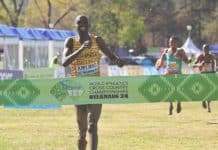News, views and noise from the non-stop, worldwide circus of Olympic sport:
● Weightlifting ● After his much-praised reports on the Russian doping scandal in 2016, Canadian law professor Richard McLaren instantly became the gold standard for investigations in the Olympic world. He’s back on stage again.
On 22 January, International Weightlifting Federation chief Tamas Ajan, who had served as Secretary General or President since 1976 – “delegated a range of operational responsibilities to IWF Vice President Ursula Papandrea, who will temporarily serve alongside Ajan in an Acting President role.”
So, while Papandrea, the President of USA Weightllifting, will serve as the head of an Oversight and Integrity Commission to figure out which allegations of the Geman ARD documentary “Secret Doping – Lord of the Lifters” are true, Ajan – in fact – continues as IWF President and has not “stepped aside” as has been previously reported.
An interim report from Papandrea’s committee is due by 11 March to the IWF Executive Board. On Friday, the IWF announced that McLaren had been engaged to “take whatever measures he sees fit to ensure each and every allegation is fully investigated and reported.”
In a related matter, the allegations made by Thai lifting star Rattikan Gulnoi – the 2012 Olympic bronze medalist in the women’s 58 kg class – that lifters as young as 13 were doping caused the entire Board of the Thai Amateur Weightlifting Association to resign on Thursday. The resignation letter noted that the ARD documentary “destroys our country’s reputation and image dramatically.”
McLaren has a lot to do.
● Taekwondo ● Iran’s only Olympic medalist Kimia Alizadeh confirmed at a news conference in Germany that she intends to stay in that country and continue to compete whether or not she is able to attend this summer’s Olympic Games in Tokyo.
She announced on 12 January on her Instagram page that she was leaving Iran and had gone to The Netherlands. But by 24 January, she was in Germany and declared that she will not return to Iran, stating (in English via Google Translate) “I am one of the millions of oppressed women in Iran” and “My troubled spirit does not fit into your dirty economic channels and tight political lobbies. I have no other wish except for Taekwondo, security and a happy and healthy life.”
Iran lost another potential taekwondo star as Farzad Zokghadri (80 kg) moved to Bulgaria and stated his intention to compete for that country. “I like Iran; this is my country,” he said, “But the competition there is tough and I’ll have much better chances to fulfill my dreams competing for Bulgaria.” He added, “I would like to say that my move to Bulgaria has nothing to do with politics.”
● Gymnastics ● The Federation Internationale de Gymnastique (FIG) had never released financial statements, but finally decided to allow some more transparency with the posting of a six-page summary.
The balance sheet showed solid assets of 52.0 million Swiss francs (1 CHF = $1.04), but paltry 2018 income of CHF 16.1 million, with a net operating income of just CHF 723,000. Including investments and one-time items, the final net income for 2018 was CHF 939,000.
That’s not a lot, and way down from the CHF 2.45 million earned in 2017. The four-year financial plan does not look a lot better: 2019 was estimated to bring in CHF 1.38 million and a loss is forecast for 2020 of CHF 4.51 million! No notes or explanatory materials were included, so there is no way to understand the break-out between FIG income from its share of Olympic television rights and its earnings from its Artistic World Championships and other events.
● Football ● The CONCACAF women’s Olympic Qualifying Tournament is underway, with two of the three group-stage match days completed.
In Group A, the U.S. and Costa Rica have qualified for the semifinals by winning their first two games, with the two teams to meet on Monday to determine the group winner. The American women, playing for the first time since November, cruised past Haiti by 4-0 on 28 January and then pounded Panama on 31 January, 8-0 (with a hat trick by Lindsey Horan), in Houston. Costa Rica defeated Panama, 6-1, and Haiti, 2-0.
In Group B, Canada smashed St. Kitts & Nevis, 11-0, and Mexico defeated Jamaica, 1-0. The remaining games are on 1 and 4 February. The semifinals and finals will be on 7 and 9 February in Carson, California. More details here.
● Canoeing ● Six-time World C-1 200 m champion Laurence Vincent-Lapointe (CAN) was reinstated by the International Canoe Federation after a doping examination panel concluded that last August’s suspension for having trace amounts of ligrandrol was caused by “bodily fluid contamination” from her ex-boyfriend.
The Associated Press reported “The Canadian canoe sprint racer and her lawyer detailed in a news program that laboratory analysis of hair from her then-boyfriend showed he was likely responsible for a tiny presence of ligandrol in her doping sample.”
Now eligible, Vincent Lapointe will be the favorite in Tokyo in the women’s C-1 200 m and in the C-2 500 m with Katie Vincent, where the pair are two-time defending world champs.
● Athletics ● World Athletics announced an amendment to its rules concerning shoes. In brief:
“From 30 April 2020, any shoe must have been available for purchase by any athlete on the open retail market (online or in store) for a period of four months before it can be used in competition.
“If a shoe is not openly available to all then it will be deemed a prototype and use of it in competition will not be permitted. Subject to compliance with the rules, any shoe that is available to all, but is customised for aesthetic reasons, or for medical reasons to suit the characteristics of a particular athlete’s foot, will be allowed.”
The federation noted that “there is sufficient evidence to raise concerns that the integrity of the sport might be threatened by the recent developments in shoe technology” and also limited soles to 40 mm and not more than one embedded plate that runs either the full length or part-length of the shoe.
World Athletics did not – as some had hoped – ban the Nike Vaporfly shoe, which has caused a sensation in distance running, especially in the marathon. Kenya’s Brigid Kosgei wore a version of the Vaporfly when she set the women’s world record of 2:14:04 last October.
An excellent review of the entire Vaporfly saga by 1968 Boston Marathon winner Amby Burfoot ran on PodiumRunner.com and is worth reading here.
¶
The second stage of the World Athletics Indoor Tour took place Friday evening in front of a full house of 5,000 in Karlsruhe (GER), highlighted by a 2.02 m (6-7 1/2) win for Ukraine’s Yaroslava Mahuchikh.
Still just 18, the mark is a World U-20 Indoor Record and her second of 2020; she cleared 2.01 m (6-7) on 18 January. She’s clearly a medal favorite for Tokyo.
Another Ukrainian star, long jumper Maryna Bekh-Romachuk, the World Championships silver medalist in Doha last year, scored a mild upset over Worlds gold medalist Malaika Mihambo (GER), winning by 6.92 m-6.83 m (22-8 1/2 to 22-5).
American Sam Kendricks told reporters prior to the meet that by his own calculations, he had cleared 5.80 m (19-0 1/4) in 16 straight meets (14, actually), but that came to an end on Friday as he managed only 5.50 m (18-0 1/2) and finished ninth. France’s Renaud Lavillenie won at 5.70 m (18-8 1/4).
Two world-leading marks were set in the 3,000 m. Kenyan Bethwell Birgen won in 7:38.50 and Ethiopia’s Fantu Worku won the women’s race in 8:37.58. Full results here.
¶
Two other recent competitions of note were the annual Dubai Marathon and the U.S. 50 km Walk trials. In Dubai, 11 men finished under 2:07 and Ethiopia’s Olika Adugna won with a lifetime best of 2:06.15. Fellow Ethiopian star Worknesh Degefa won the women’s race in an impressive 2:19:38.
Former Swede Andreas Gustafsson won the U.S. 50 km Olympic Trials held in Santee, California in 4:12:11 on 25 January. That time is well beyond the qualifying standard of 3:50:00 and would have ranked 139th in the world for 2019. The women’s 50 km Walk is not an Olympic event for 2020, but Robyn Stevens won the women’s race in 4:37:33, the no. 6 performance in U.S. history.
¶
Star miler Edward Cheserek, a native of Kenya, has long wanted to compete for the U.S. internationally. Now 25, and with very little movement on his application for American citizenship, told Athletics Kenya that he would run for his native country.
Cheserek lives and trains in Arizona, but will now have to try to navigate the Kenyan qualifying system to try to get to Tokyo.
● At the BuZZer ● Further to our Lane One column of 27 January, opining that if athletes were paid at the Olympic Games, it’s an open question as to whether many of the events would be dropped, two-time race walk Olympian Allen James replied:
“There are ways to compensate athletes that would not complicate the aspects Rich touches on. We have new technologies, formerly never available, that can enhance competition presentation such as athlete data. Athlete data, is solely owned by the athlete and in at least in the United States is protected by HIPAA laws.
“Game presentation can include athlete heart rates and other data that can be projected on to monitors or used as predictive factors while watching the event. It’s like the evolution of e-sports where viewers can see gamer data as the battles ensue and allow viewers to see realtime stats of the gamers. We can all see where the world of e-sports is going. Perhaps we’ll even be able to have augmented reality viewing, stuff that is really cool. I apologize to the little bit of info streaming, but this is ultimately where I was going, and no tier sport or events should be considered for removal, especially the Modern Pentathlon.
“As for the walks, consider what augmented reality could do, imagine The Far Side meets the Olympic walks, your favorite athlete actually becomes the cheetah speedwalker. The L.A. Clippers are playing with augmented reality like lighting up athletes when they’re hot and then their 3 pointers flame through the hoop, in near realtime viewing. Where the money comes in is for the athlete’s data and use of likeness for these alternate revenue streams.”




















